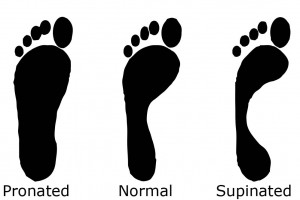Foot types and proper footwear
Our feet go through a lot everyday as the forces exerted by the body during walking can increase up to 1.5 times and up to 3 times during running. Add in 10,000 steps during a typical day while (possibly) wearing ill-fitted shoes – its no wonder we want to put up our feet at the end of the day. Knowing your foot type is critical to finding the right shoe to make every step count!
Which foot type are you?
1. Flat Foot (Pronation)
- The foot rolls inward and flattens (pronates) with weight bearing, placing increased stress on the inner foot structures.
- This is typically a flexible foot, providing decreased stability during walking.
- This person tends to wear out the inner side of the shoe, to include under the big toe. Calluses can be seen frequently under the base of the 2nd and 3rd toes and inside of the big toe.
- If this person’s shoe is placed on a flat surface, the shoe may tilt inward.
- Related problems include metatarsal stress fractures, plantar fasciitis, Achilles tendonitis, patellar pain, and hip pain.
Proper Shoe
- A flat foot benefits from a motion control shoe – a heavier, less flexible shoe. This limits excessive inward motion and helps stabilize the foot, which is typically too flexible.
- The midsole is the part of the sole that provides most of the cushion and support. For a motion control shoe the midsole likely is a firm, dual density material, denser on the inside at the arch and heel.
- The last refers to the method of attaching the upper to the midsole/outsole, and also the shoe curvature shape. A motion control shoe typically has a board last, with a straight to semi-curved last shape.
- The heel counter (the area surrounding the heel) is very firm to squeeze, providing stability in the heel
2. High Arched Foot (Supinator)
- The high arched foot tends to be a more rigid, less flexible foot with more weight borne on the outside part of the foot.
- Less shock absorption occurs in the foot. Consequently more forces are transmitted up the leg to the trunk.
- This person tends to wear out the outer side of the shoe from heel to toe. Calluses may be seen along the outer edge of the foot to the base of the 5th toe.
- If this person’s shoe is placed on a flat surface, the shoe may tilt outward.
- Problems seen with this type of foot include stress fractures in the tibia or femur, Achilles tendonitis, and plantar fasciitis.
Proper Shoe
- A high arched foot benefits from a cushioned shoe providing shock absorption. This reduces the amount of impact transmitted upwards through the legs.
- The midsole is a softer, more flexible, single density material, providing less support and more cushion.
The last is a slip last (sewn down middle of shoe sole), with a curved or semi-curved last shape.
3. Neutral Foot
- This is a more desirable foot structure. The foot pronates, or rolls inward, initially with weight bearing, but when the person is ready to push off with the forefoot and toes while walking, the neutral foot adjusts to provide stability. The neutral foot therefore provides a combination of shock absorption and stability at the appropriate times during walking or running.
- An even wear pattern on the shoe sole is expected with a minimum of calluses.
Proper Shoe
- The neutral foot benefits from a stability shoe, which provides both cushioning and pronation control.
- The midsole frequently is a dual density material limiting excessive movement inward and providing cushion.
- The last is combination lasted (board lasted in heel, slip last in the forefoot) with a semi-curved last shape.
Reference: McKinley Health Center 2009, Foot types and proper footwear, viewed 15 August 2015, http://www.mckinley.illinois.edu/handouts/foot_types/foot_types.htm

